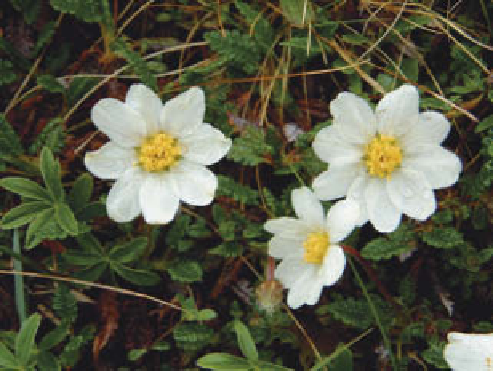Geoscience Reference
In-Depth Information
medium term, anthropogenic climate change will
undoubtedly lower the productive capacity, usefulness
and stability of the land surface through its collective
geological and geomorphic consequences.
ECOLOGICAL IMPACTS OF
Impacts on soil processes and soil
properties
The importance of the climate factor in soil formation
(
Chapter 18)
means that predicted changes in tempera-
ture, precipitation and evapotranspiration will have direct
and complex effects on soil processes and soil properties.
Climate changes will also affect soils indirectly through
changing vegetation type and biomass. Three important
impacts on soil fertility and sustainability are discussed
here: soil hydrology, soil organic matter and soil
organisms. In an interacting system like soil, changes in a
single property will cascade into related properties, thus
increasing the difficulty of making accurate predictions.
alpine calcicole, here growing in the mountains of Assynt,
Scotland. The arctic-alpine flora of Britain has survived in the
face of many pressures, especially from land-use changes.
However this prized flora faces a big threat from climate
warming and consequent competition from more vigorous
plants migrating uphill.
Photo: Michael Raw
extend to submarine landslides, triggered by the additional
seismic activity, compressive loading and coastal erosion
generated by rising sea level discussed at the start of this
section. Such interlinked processes are believed to have
caused the Störegga slide off the south-west Norwegian
coast, during the Holocene, involving 5,000 km
3
of marine
sediments over an area of
Soil hydrology
Climate-change impacts on soil hydrology are important
because of the key role of soil water in determining plant
productivity and facilitating many soil processes. Water
retention in soils depends upon texture, soil structure and
organic matter content. Structure is affected by wetting
and drying cycles, and by dehydration cracking in clay
soils. Organic matter is predicted to decrease (see below).
Any change in soil structure will also influence porosity
and permeability, and hence surface run-off and infiltra-
tion rate. Climate change will also influence soil wetness
through changes in precipitation; increased evapotran-
spiration may be beneficial for waterlogged soils but cause
drought problems in well drained soils. The timing
of work days is an important factor for the success of
mechanized, arable cropping in the United Kingdom.
'Machinery workdays' define the period of time in
autumn, spring and early summer when soils are
sufficiently dry to withstand the traffic of farm vehicles
without structural breakdown. Changes in precipitation
totals and seasonality will affect crop management because
of changes in machinery workdays. Soil erodibility also
depends on structure and organic matter, and will be
worsened by the climate-induced changes in topsoil
organic matter content, due to its effects on soil shear
strength and aggregate stability. Water erosion will also be
increased by reduced infiltration and greater run-off.
30,000 km
2
and triggering
tsunamis around north-east Atlantic coasts. The impact
of rising sea level on coastal volcanic activity extends to
enhanced landslide risk on the exposed seaward slopes of
oceanic volcanoes. Paraglacial slope instability will
increase as the buttressing effect of glaciers on adjacent
slopes is removed. The increasing depth and water content
of the annual active layer create a detachment surface for
shallow landslides at its contact with underlying frozen
ground or permafrost, in addition to
in situ
ground heave
and collapse.
The speed, extent and variability of climate change of
course also disturb the degree to which soil, vegetation,
land-use and other human activities are in equilibrium
with existing climate, and it is appropriate to apply the
term
land degradation
to their collective impacts. This is
often exacerbated where land is abandoned through loss
of productivity and its management ceases. In many cases
- although not all - the impacts will not be catastrophic
and new equilibria may be achieved, given time and
stabilization of climate itself. However, in the short to









































